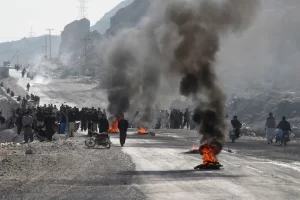Editor’s note: On February 7th, a day before Pakistan’s national election, two explosions outside the offices of political candidates in Balochistan killed at least 24 people, according to officials there. No group has claimed responsibility.
Iran and Pakistan have historically had good relations. Iran was the first country to recognise Pakistan after the partition of British India in 1947. The two countries co-operate closely on trade and defence. But the activities of Baloch militants in the region that straddles their border have long been a source of friction. Several groups operate there, often acting jointly. Recently the situation has grown worse. On January 16th Iran fired missiles into western Pakistan, saying it was aiming at Jaish al-Adl, Sunni militants whom it considers to be terrorists. Pakistan then fired missiles into eastern Iran, at what it called “terrorist hideouts”. Both countries recalled their diplomats, then quickly decided to patch things up. Their foreign ministers met on January 29th in Islamabad, Pakistan’s capital, where they agreed to fight the militant groups in their respective countries. On February 2nd, less than a week before a national election, Pakistan said it had killed 24 militants in Balochistan. What is going on there?
The region takes its name from the ethnic group that makes up a majority of its people. The Baloch were once a group of nomadic tribes. Some historians reckon that they settled on the fringes of modern-day Iran as early as 1200 BC. Over the centuries Balochistan was beset by invasions. After the Arabs conquered it in the 7th century AD most Balochs converted to Islam. In the late 19th and early 20th centuries the British and Persian empires split the region between them, and gave part of it to Afghanistan. Iran annexed West Balochistan in 1928. After the British withdrew in 1947, Pakistan took the eastern part.
Those haphazard divisions have had troubling consequences. Baloch nationalists in Pakistan—who feel that the Punjabi, the country’s largest ethnic group, has sidelined and impoverished them—have sporadically fought against the government since 1947. Some 8,000 people were killed in the 1970s during the most serious bout of violence. The latest insurgency began in the mid 2000s. The militants’ attacks are becoming increasingly sophisticated. In 2022 the Balochistan Liberation Army co-ordinated explosions in at least six cities, killing several members of Pakistan’s security forces. Pakistan’s response increased tensions: according to human-rights groups, the government unlawfully detained and tortured Baloch leaders. Many of the group’s members fled to Afghanistan and Iran, from where they have launched attacks on Pakistan.

Iran’s Balochs have complaints, too. Many live in terrible conditions: the Sistan and Balochistan region is the poorest in the country. The Iranian government, a Shia theocracy, represses minorities, including the largely Sunni Balochs. Baloch militants gained a foothold in Iran in the early 2000s. Beginning in 2005 one group, Jundullah, or “soldiers of God”, staged a series of attacks on Iranian officials, taking hostages and occasionally killing them. In 2006 they killed more than 20 Iranians. Jaish al-Adl—which Iran says has bases in Pakistan—is probably an offshoot of Jundullah. The militants have launched larger attacks on Iran in recent months, including one that killed at least 11 Iranian police officers in December 2023.
Instability in Balochistan makes it harder for both governments to exploit the region’s resources, which include natural gas, oil and large reserves of copper and gold. Militants have often attacked gas infrastructure, delaying the construction of a big Iran-Pakistan pipeline that will pass through the region. And they have vigorously opposed the construction of a Chinese-funded mega-port at Gwadar, a Pakistani city on the Arabian Sea near the Iranian border. Militants have attacked Chinese workers on the project, which provoked Pakistan’s government to impose heavy-handed military control of the area.
In the meetings on January 29th Iran and Pakistan agreed to co-operate to suppress the insurgencies on their border. Iran’s foreign minister said that the two governments would “not let terrorists…threaten” their joint security. That might be good for regional stability. But it does not promise a solution to the complaints of the Baloch people.